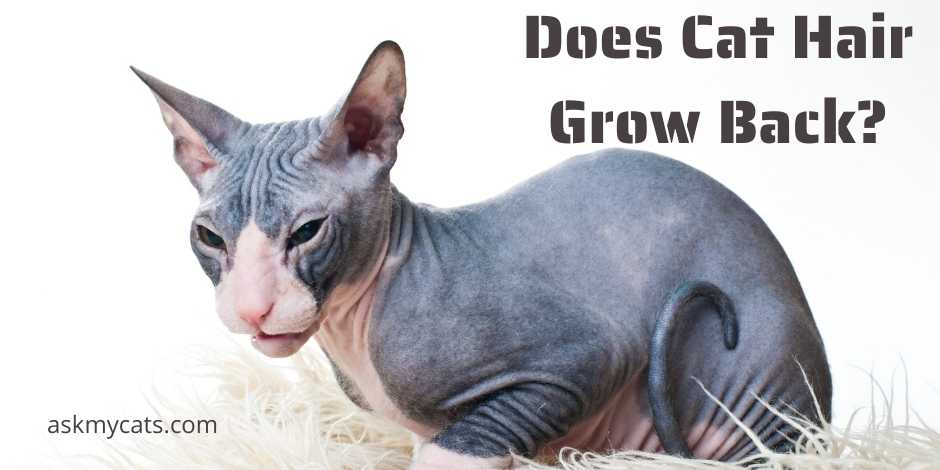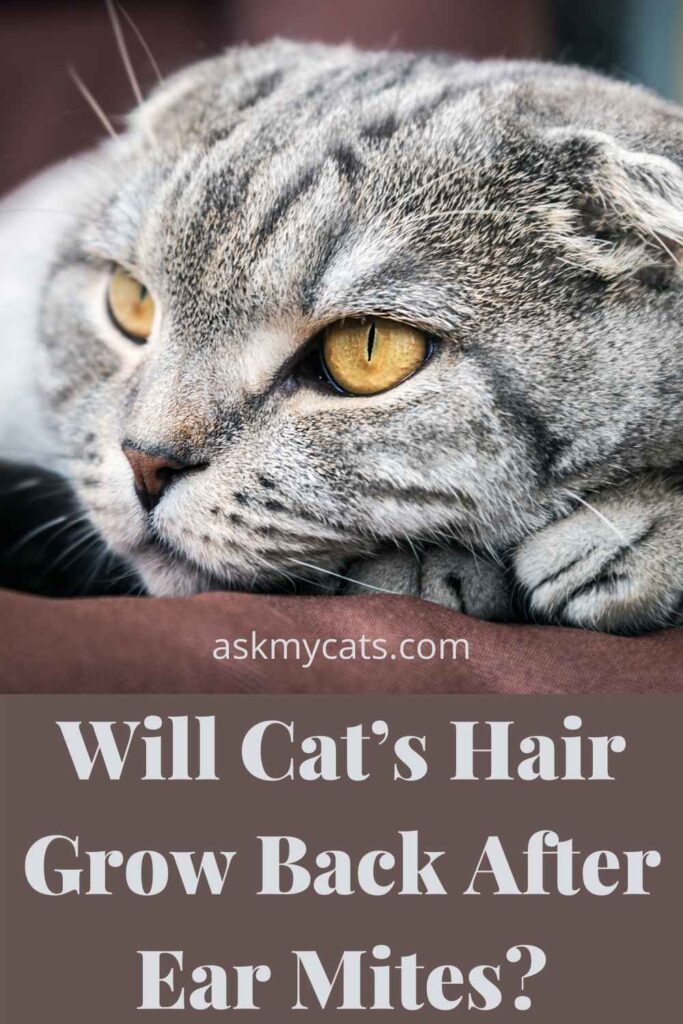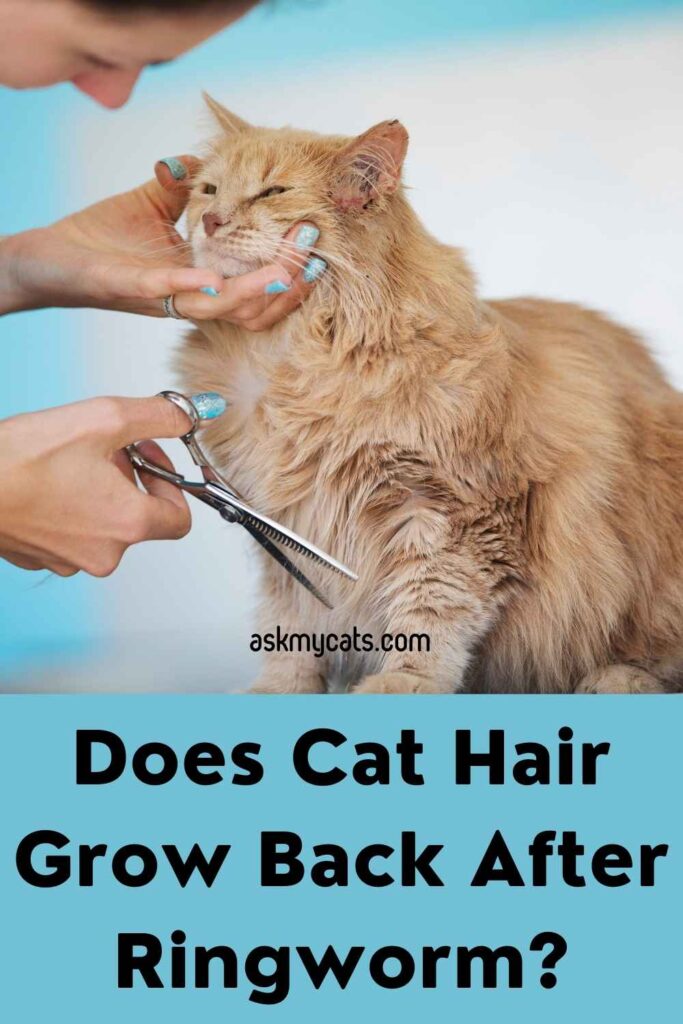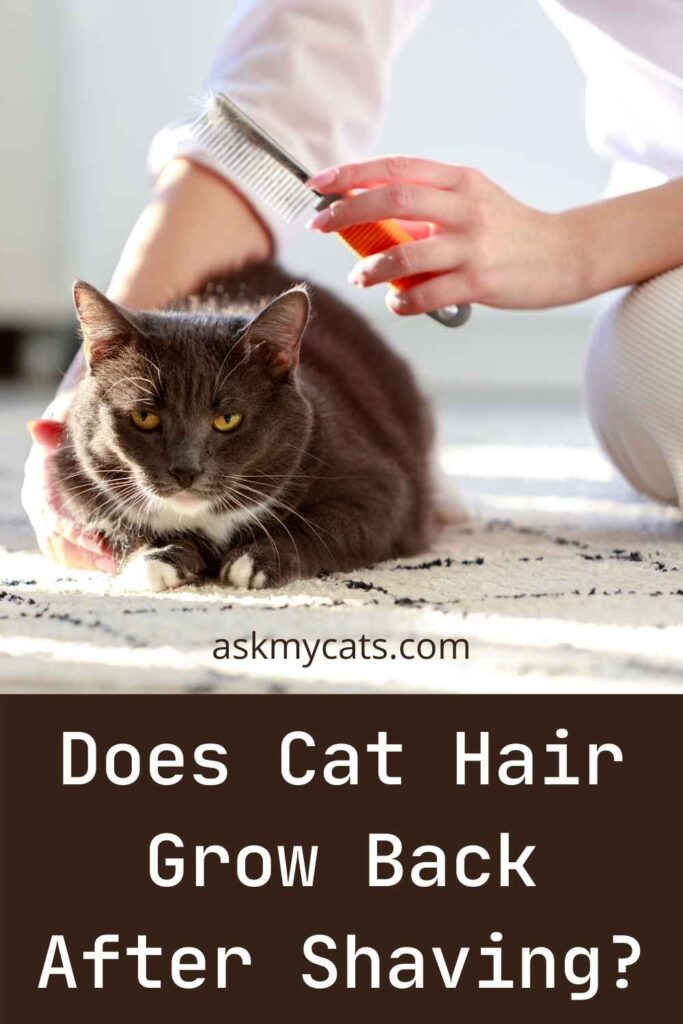A Cat’s fur should grow back fine if he’s fully shaved or given a specialized lion trim. Fur will take four to six months to regrow fully in long-haired cats. If you shave a short-haired cat, his fur can regrow in under three months.
Hair development is influenced by a variety of influences, so you’ll want to know what’s natural for your cat and what to look out for.
I’d give them vitamins and extra calcium now that I’m aware of, something I wasn’t aware of back then.
Once I was confident the cuts were healed, I’d apply some coconut oil to the affected areas.
This will aid in their fur’s faster growth, as well as keep it safe and lustrous.


Give Your Cat the Perfect Day
Get the Free Ebook!
How Fast Does Cat Hair Grow?
It can take up to 12 weeks on average to grow back full hair in cats.
However, just like some people’s hair grows faster than others, animals’ hair will grow faster or slower as well. There are occasions when a cat or dog’s fur does not completely regrow. And, at the very least, not in the manner it was when it was shaved.
We’ve never had a cat that needed grooming or some sort of treatment apart from the fact that they’ve been spayed or neutered. Any of them had it done when we took them in when they were adopted from a shelter.
Recently, a kitty (at the shelter where I volunteer) was diagnosed with skin cancer and had part of his fur shaved. Fortunately, he was placed in foster care, and his foster family wanted to adopt him.
If the cat is in good condition, its hair can regrow very quickly. A short-haired cat, on the other hand, is even faster.
When my cats underwent surgery, the shaving spots covered the incision, or wound area, within a month or two. The fur remained shorter for a month or two after that, until you couldn’t tell where the trimmed patch was.
I’d give them vitamins and extra calcium now that I’m aware of, something I wasn’t aware of back then. Once I was confident the cuts were healed, I’d apply some coconut oil to the affected areas.
This will aid in their fur’s faster growth, as well as keep it safe and lustrous.
A cat’s current fur may have a different texture from his previous coat in some instances. It could be thinner or thicker than it was before.
Your hair is always growing on your head. Your pet’s hair does not grow in the same way as yours does.
Rather, a new hair appears just after the original one has fallen out.
When shaving, it’s important to leave at least an inch of fur behind. This allows the old hairs to fall out at the end of their cycle while allowing new hairs to grow in.
Hair that is cut too short may become embedded, resulting in discomfort, frustration, and hairlessness.
Take him to the vet for a check-up if his hair doesn’t appear to be growing back.
You might also like to read about reasons behind cat losing hair on ears
Will Cat’s Hair Grow Back After Ear Mites?
Yes, a cat’s hair can grow back after ear mites because they do not cause permanent damage to the hair.

Ear mites normally only damage the ears, but they can cause hair loss behind the ears due to scratching, and they can infect the head, body, and even the tail/rump while the cat is curled up.
By examining the ears under a microscope, the veterinarian will quickly identify ear mites and administer easy medication.
Ear mites are parasitic insects that dwell in animals’ ear canals.
Otodectes cynotis, which lives in the external ear canal of dogs and cats, is the most widely used parasite in veterinary medicine (responsible for roughly 90 percent of ear mite infections seen in cats).
Around the ear, a brownish waxy film accumulates (looks like coffee grounds). Animals scratch their eyebrows and shake their heads regularly. Ear mites behave as small white dots in the ear canal that move around.
Most pet supplies stores sell over-the-counter topical treatments, but they do not destroy mite larvae, so care will last up to 30 days.
Your veterinarian will recommend single-use solutions that normally remove ear mites after only one use.
Revolution is the most common of these brands, and the one we suggest at RAH. To get rid of the waxy brown debris (and as many mites as possible) at the start of treatment, a thorough ear cleaning is needed.
Outdoor cats are the most susceptible to ear mites. This isn’t to say that your indoor cat won’t get ear mites; note, what it takes is one random meeting with an infected animal!
Even though ear mites are less frequent in dogs, they can still get them, particularly if they live with an outdoor cat.
There is no foolproof way to save your dog or cat from getting ear mites.
Using a device like Revolution on a daily basis is the safest preventative measure (once a month, year-round). This will not only prevent your pet from getting ear mites, but it will also protect it from other parasites like fleas, ticks, and intestinal parasites like roundworms.
It's interesting to know Can You Shave A Cat? Pros And Cons Of Shaving Cats
Will Cat’s Hair Grow Back After Fleas?
YES. Cat’s hair can grow back after fleas. Only one flea bite in cats can result in serious and chronic scratching, which can lead to hair loss and open sores or scabs on the skin, causing a secondary bacterial infection to develop.
The problem is usually triggered by your cat’s response to the flea’s saliva, which causes a localized reaction, particularly on the back and towards the tail.
Fortunately, the issue is generally simple to resolve, and the hair will regrow after the fleas or mites have been removed.
The most frequent cause of bald patches in cats is parasites such as mites or fleas.
This disease is better handled with parasite-killing items such as ‘spot-on.’ Veterinarian-recommended products are usually the most effective, although alternative medications, such as steroid therapy, can be used to alleviate itching.
External parasites, such as fleas, may induce feline-acquired symmetric alopecia, which is characterized by significant fur loss on both sides of the cat’s body.
Check out more details about can i shave my cat to get rid of fleas
Does Cat Hair Grow Back After Ringworm?
Ringworm in cats is not anything to be taken lightly. If it goes out without care, it will take anywhere from nine months to a year, during which time the animal’s fur will continue to fall out and its naked skin will become visible.

Ringworm is a fungal infection, not a parasite, that causes circular lesions on the skin where the hair thins or disappears completely, giving your cat the appearance of a bald spot.
Ringworm is a highly infectious fungus that can be spread by close contact with the spores.
Since these parasites can survive for up to two years, your cat can contract them from any place where an infected animal has been.
A fungal culture on a sample of hair is normally used to diagnose ringworm, but inspecting the hair under a microscope or using a UV lamp (wood’s lamp) to examine the whole hair coat may also give clues.
A swab of the skin may be used to spot ringworm, and the parasite is usually treated with shampoos or other medications to prevent it from spreading.
When the skin and coat are viewed in a dark space under a special ultraviolet light called a Wood’s lamp, the majority of cases of feline ringworm caused by M. canis can glow with a yellow-green fluorescence.
However, not all cases of dermatophytes fluoresce clearly, and certain other dermatophytes species do not fluoresce under a Wood’s lamp.
As a result, further diagnostics could be needed to validate the presence of ringworm fungi. Any skin ointments and other products fluoresce as well, resulting in a false positive.
Laboratory culture of the fungus is the most accurate tool for diagnosing ringworm in cats. Hair and skin scrapings are taken as samples for this.
A positive culture can often be confirmed within a few days, but in some cases, the fungal spores are slow to mature, and culture findings can take up to four weeks, so a reported case cannot be ruled out for at least a month.
Hair loss in cats can be caused by a variety of factors. Your veterinarian may prescribe additional testing to rule out any of these causes before diagnosing ringworm.
If aggressive therapy is used, infected cats are infectious for around three weeks.
If only limited steps are taken or if you do not follow the prescribed approach, the ringworm can last longer and be infectious for a longer period of time.
During this time, it’s best to limit your proximity to other dogs or cats, as well as your family members. Two successive negative fungal cultures suggest that your cat has been successfully handled.
Is Hair Loss From Ringworm Permanent?
The hair in the bald spots would most likely regrow if you treat ringworm early. The bald spots can become permanent if you do not handle them.
The condition is also known as scalp ringworm. The signs and symptoms vary, but itchy, dry/flaky bald patches on the scalp are the most frequent.
Ringworm may also cause extreme inflammation and permanent hair loss in some cases.
Staph bacteria or fungi are normally to blame. It can appear everywhere on your face, including the scalp, where hair grows.
Folliculitis that affects the scalp can cause temporary hair loss in addition to causing tiny, itchy bumps on the skin. Hair normally grows back with adequate care.
Oral medications such as terbinafine (Lamisil) or itraconazole (Sporanox) are used to treat fungal scalp infections for 6 to 12 weeks, with or without shampoos containing selenium sulfide (Selsun Blue, Head & Shoulders, among others) or ketoconazole (Nizoral).
Does Fur Grow Over Scars?
Scar tissue does not have any hair follicles, so hair does not normally grow there in cats.
Hair follicles are tiny capsules that retain and regrow hair under the skin. Follicles expand and heal with the aid of blood vessels under them. Hair follicles should not regrow as a scar develops on damaged skin.
In most cases, a cut or incision can be almost healed following surgery or therapy in about 2 weeks. After about three weeks, a scar would appear.
Supplementing with fish oil will help hair regrow and cover the wound, but only if the hair follicles haven’t been affected. Some dogs can scar more easily than others.
Does Cat Hair Grow Back After Shaving?

Fur will take four to six months to regrow fully in long-haired cats after shaving. If you shave a short-haired cat, his fur can regrow in under three months after shaving.
You should generally stop brushing your cat’s hair.
Shaving cats can result in the removal of defensive hairs that aid in body temperature regulation.
Shaving the cat will also cause discomfort and anxiety. Hair that is too matted or tangled should be trimmed by a skilled groomer.
Cats have a built-in insulator in the form of their feathers.
They will stay warm in the winter and cool in the summer thanks to this self-regulating process.
Isn’t nature incredible? It’s always vital to keep your cat hydrated with fresh water, but it’s not appropriate to shave your cat.
How Long For Cat Hair To Grow Back After Spaying?
The coat should grow back in 2-3 months after the operation the small incision in the skin is sutured (stitched).
If your cat’s fur isn’t growing back after being cut, it may be attributed to a hormone deficiency or imbalance.
If your cat is balding in patches, it may be due to a bacterial infection, ringworm, or demodicosis. For societies, the veterinarian may need to scrape your skin or pluck hairs.
Certain cats will need more grooming than others, but all cats will benefit from brushing on a daily basis to remove dead fur and encourage new growth.
Diet: For healthy skin and fur, a nutrient-dense diet with the right amount of protein, vitamins, and minerals is important.
Frequently Asked Questions
Is it cruel to shave a cat?
While shaving a cat isn’t normally appropriate, it isn’t cruel if handled properly by a professional and the cat isn’t disturbed or depressed throughout the procedure. Grooming-induced aggression in cats can cause them to jump so much that they fear being cut. They can also cause harm to the grooming expert.
What should I do if my cat is losing hair?
Finding out what’s behind your cat’s fur loss is the first step of recovery. If you notice your cat is losing hair, take him to the doctor for an examination. The sooner the trigger is identified, the sooner the cat will feel better and be able to regrow their coats.
Final Words
If your cat has developed baldness as a result of an allergic reaction to a flea bite, your veterinarian can prescribe an injection or other medication to help mitigate the allergic reaction and relax the region.
When the inflammation subsides, hair normally regrows.
Anti-anxiety drugs, synthetic feline facial pheromone mist, and other soothing aids can also be beneficial.
Tick and flea prevention medicine should be used on a regular basis to keep the cat safe and rule out certain parasites as a cause of fur loss.
